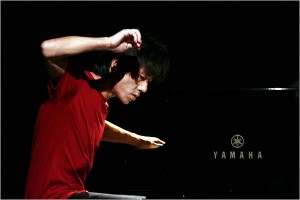Acclaim
Review
BUILDING ON BACH, DRAWING ON DEBUSSY

The pianist Taka Kigawa has built a loyal following with his annual recitals at the Greenwich House Music School, and when he moved a few blocks east to Le Poisson Rouge on Monday evening, his listeners came with him.
In the 15 months that this club has been open, I have not seen it as crowded for a classical performer as it was for Mr. Kigawa, and it was not as if he were offering a facile program: he began with two works by Pierre Boulez and one by Tristan Murail, and he ended with a handful of Gyorgy Ligeti’s Études. Between the Murail and Ligeti works, he played the first and last sections of Bach’s “Art of Fugue.”
In his comments between works, Mr. Kigawa mentioned that the Bach was the common ground on which all the other composers stood, in the sense that they all studied “The Art of Fugue” at some point in their compositional journeys. You wanted to believe him: his performance of the Contrapunctus 1 was sensitive and deeply considered, with its individual lines painted in subtle gradations of color and weight, and the Contrapunctus 14 had a dark hue and a deeply melancholy spirit that seemed to prefigure the fugue’s sudden ending, where Bach left it incomplete.
But those were not the qualities that informed the program’s other scores, or Mr. Kigawa’s renderings of them. Instead, it often seemed as if the ghosts of Debussy and Ravel hovered over his piano. In bringing out the dreamlike qualities of Mr. Boulez’s “Incises” (1994), he let the music’s smudges, swirls and faltering rhythms melt into the fleeting hint of a Debussian haze.
At the very least, Debussy’s influence on Mr. Boulez seemed clearer than usual. And Debussy’s more puckish, mischievous side could be heard just below the surface of the faster movements of Mr. Boulez’s “12 Notations” (1945), even if the spare, sometimes mechanistic language reached toward a universe where Debussy sounded quaint.
Ravel’s influence is unmistakable in the graceful shimmer and sparkling textures of Mr. Murail’s “Mandragore” (1993). It was only in Mr. Kigawa’s alternately energetic and introspectively delicate readings of five Ligeti Études (1985-2001) that the influence of the Impressionists faded, though it did not evaporate entirely: the steady beat and angular melodies of “Cordes à Vide,” for example, were wrapped around cloudy harmonies that owed something to Debussy.
But other selections took their own paths. Mr. Kigawa reveled in the bustling jazz rhythms of “Désordre,” and he brought a magnificent clarity to the rising chromatic figures in “L’Escalier du Diable.”